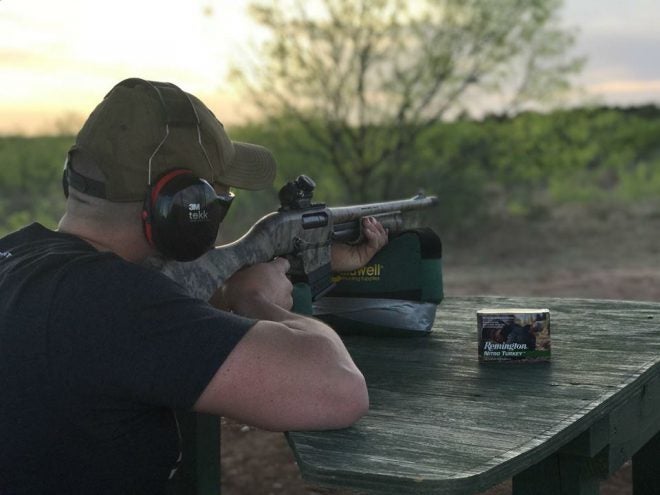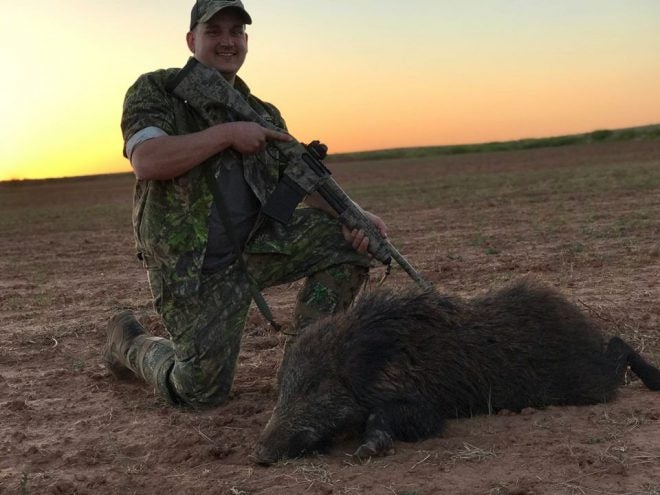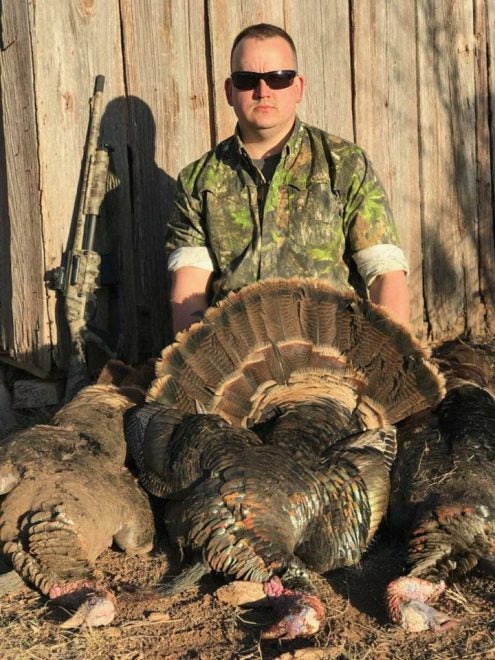Review: Remington 870 DM Predator Pump Shotgun
Ken Whitmore 05.07.18

Sunshine, blue skies, and a warm breeze met me in Abilene, Texas when I arrived at my destination. I’d been lucky enough to be invited on a Remington hunt at The Spike Box Ranch in Benjamin, Texas where I’d get some hunting time with their new shotgun, the 870 DM Predator.
I’ve been an avid turkey hunter for twenty years and most of my turkeys have been taken with the tried-and-true Remington 870. When I was 11 years old, it was the first shotgun I fired. As a new hunter, I took countless squirrels while accompanying my dad through the western Pennsylvania woods. And now, in Texas, I’d stepped into a whole new territory and turkeys weren’t the only thing on the menu. Hogs and coyotes were on the hit list and I was eager to get into the field and have some fun with the new design using a box magazine instead of the venerable tube-fed model.
Both 3- and 6-round magazines are available for the Remington 870 DM Predator. For the most part I stuck with the 3-round magazines, partly because I’m used to Pennsylvania’s capacity regulations, but also to keep less weight on the gun. It comes with a Kryptek Highlander finish which blended in extremely well with the central Texas landscape. The gun ships with a Trulock X-Full Turkey/Predator choke which patterned well at 25 yards. The factory XS Ghost Ring sights are precise, and the integral rail was useful for mounting an optic.
The XS Ghost Ring sights are a definite upgrade over the basic front bead sights on most shotguns, but I opted to run a mini-red dot, the AT3 Tactical’s RD-50. The shotgun was going to be used as a truck gun at night for hog and coyote hunting, so I wanted the versatility of a red dot for fast-moving targets as well as the ability to dial in the pattern for turkey hunting.
Believe it or not, in Texas it’s legal to dispatch hogs and coyotes from a moving vehicle. The 18.5” barrel on the Predator proved it could move quickly within the confines of a truck cab and during the day it was handy inside a box blind while turkey hunting. The Remington ShurShot stock was ergonomic and carried well through the wheat fields and patches of mesquite, and the SuperCell Recoil Pad was also very comfortable even while shooting Remington’s 3” Nitro Turkey #4 and 3” Express Magnum 00 Buckshot loads.
At one point, I committed to a 500-yard stalk on a lone sow feeding in a wheat field. The ShurShot stock provided a comfortable grip on the shotgun even as I kept it at the ready. I closed the gap to 35 yards and was able to put multiple rounds of 00 buckshot on target, dropping the sow mid-stride, thanks in part to flawless feeding from the box magazine.
On the second morning we got skunked. After hours spent watching almost two dozen hens feed 20 yards from my seated position up against a mesquite, it became clear that no longbeards were going to come investigate. After regrouping over lunch, we decided to change gears and sit in a more productive box blind. Within three hours, I’d tripled on three longbeards, one of which had a 10” beard and 1.25” spurs. Every time a gobbler wandered in, he was met with a Remington 3” Nitro Turkey load of #4 shot. Ranges varied from 20 to 35 yards and the outcomes were all the same. The birds went down hard and with every shot my confidence in the new shotgun’s design grew.
The 870 DM Predator really proved a few things to me. I’d be lying if I said I didn’t expect small issues with feeding. After all, the old 870 design has been practically bulletproof in my experience. Changing the feeding system would be no simple task, but in my opinion, Remington succeeded. It appears the engineers at Remington essentially created an upgrade to allow shooters to use a box magazine, blocking off the old tubular magazine. Because the magazine tube is integral to the pump-action mechanism, it had to stay (at least in part).
After running the gun in Texas, I’m a fan of the new feeding system. I can honestly say I believe it has a place in the hunting and defensive shotgun worlds. Like many people who have gotten used to tube-fed magazines, I wondered if the detachable box magazine-fed design would be just a gimmick. This was affected somewhat by my time in the service when I was trained to top off a shotgun in combat situations. Not once in my life had I thought a box magazine-fed pump-action shotgun was warranted, but I’ve seen the light.
The shotgun shines at basic functions. It’s worth repeating that the cycling of shells was almost boringly regular. Clearing the shotgun when I returned to the ranch was a breeze, only requiring I drop the magazine and rack the action rearward to extract the chambered shell. Gone are the days of racking a pump back and forth to clear a shotgun. Another benefit was the ability to easily switch types of ammo, which came in handy hunting hogs, coyotes, and turkeys. Dropping the magazine, extracting the single chambered shell, and throwing in a new 6-round magazine of buckshot was quick and efficient. Also, the combination of the 18.5” barrel and X-Full choke worked well, providing a lethal grouping once it was dialed in.
The only issue was that it was hard to insert a loaded magazine with the action closed. The best way to properly seat a magazine in my shotgun was with the action open. While it isn’t necessarily a flaw, in my opinion, it is something to be aware of — because if the magazine isn’t fully seated, the bolt will not properly strip a shell from the magazine and chamber it.
By the end of the hunt, I didn’t want to give the shotgun back. Aesthetically, the Kryptek Highlander finish looks great. The ShurShot stock is functional and ergonomic. The trigger felt good even dirty with clay-colored Texas dust. The Predator fed and cycled flawlessly. Above all, it drops birds with ease. What else can you ask for?


